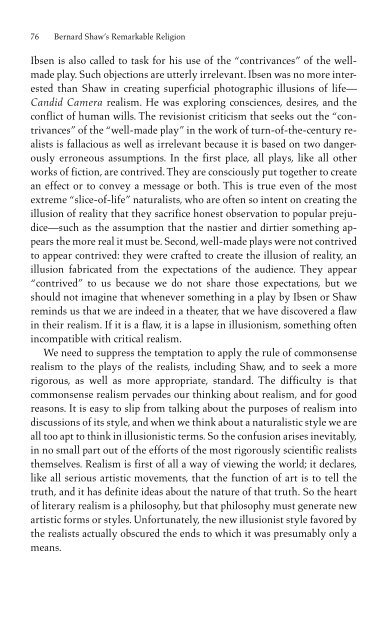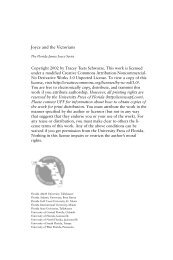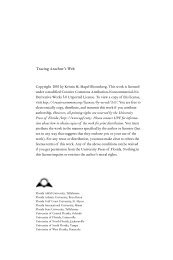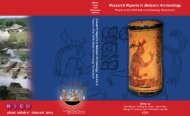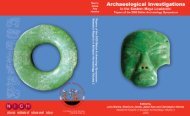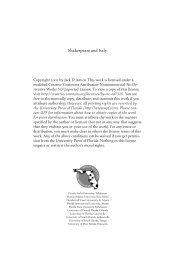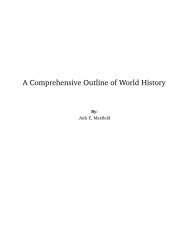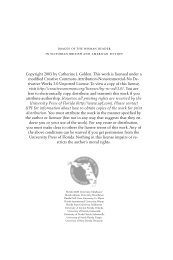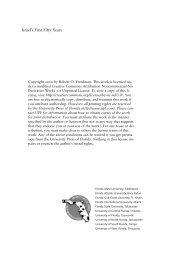Bernard Shaw's Remarkable Religion: A Faith That Fits the Facts
Bernard Shaw's Remarkable Religion: A Faith That Fits the Facts
Bernard Shaw's Remarkable Religion: A Faith That Fits the Facts
You also want an ePaper? Increase the reach of your titles
YUMPU automatically turns print PDFs into web optimized ePapers that Google loves.
76 <strong>Bernard</strong> Shaw’s <strong>Remarkable</strong> <strong>Religion</strong><br />
Ibsen is also called to task for his use of <strong>the</strong> “contrivances” of <strong>the</strong> wellmade<br />
play. Such objections are utterly irrelevant. Ibsen was no more interested<br />
than Shaw in creating superficial photographic illusions of life—<br />
Candid Camera realism. He was exploring consciences, desires, and <strong>the</strong><br />
conflict of human wills. The revisionist criticism that seeks out <strong>the</strong> “contrivances”<br />
of <strong>the</strong> “well-made play” in <strong>the</strong> work of turn-of-<strong>the</strong>-century realists<br />
is fallacious as well as irrelevant because it is based on two dangerously<br />
erroneous assumptions. In <strong>the</strong> first place, all plays, like all o<strong>the</strong>r<br />
works of fiction, are contrived. They are consciously put toge<strong>the</strong>r to create<br />
an effect or to convey a message or both. This is true even of <strong>the</strong> most<br />
extreme “slice-of-life” naturalists, who are often so intent on creating <strong>the</strong><br />
illusion of reality that <strong>the</strong>y sacrifice honest observation to popular prejudice—such<br />
as <strong>the</strong> assumption that <strong>the</strong> nastier and dirtier something appears<br />
<strong>the</strong> more real it must be. Second, well-made plays were not contrived<br />
to appear contrived: <strong>the</strong>y were crafted to create <strong>the</strong> illusion of reality, an<br />
illusion fabricated from <strong>the</strong> expectations of <strong>the</strong> audience. They appear<br />
“contrived” to us because we do not share those expectations, but we<br />
should not imagine that whenever something in a play by Ibsen or Shaw<br />
reminds us that we are indeed in a <strong>the</strong>ater, that we have discovered a flaw<br />
in <strong>the</strong>ir realism. If it is a flaw, it is a lapse in illusionism, something often<br />
incompatible with critical realism.<br />
We need to suppress <strong>the</strong> temptation to apply <strong>the</strong> rule of commonsense<br />
realism to <strong>the</strong> plays of <strong>the</strong> realists, including Shaw, and to seek a more<br />
rigorous, as well as more appropriate, standard. The difficulty is that<br />
commonsense realism pervades our thinking about realism, and for good<br />
reasons. It is easy to slip from talking about <strong>the</strong> purposes of realism into<br />
discussions of its style, and when we think about a naturalistic style we are<br />
all too apt to think in illusionistic terms. So <strong>the</strong> confusion arises inevitably,<br />
in no small part out of <strong>the</strong> efforts of <strong>the</strong> most rigorously scientific realists<br />
<strong>the</strong>mselves. Realism is first of all a way of viewing <strong>the</strong> world; it declares,<br />
like all serious artistic movements, that <strong>the</strong> function of art is to tell <strong>the</strong><br />
truth, and it has definite ideas about <strong>the</strong> nature of that truth. So <strong>the</strong> heart<br />
of literary realism is a philosophy, but that philosophy must generate new<br />
artistic forms or styles. Unfortunately, <strong>the</strong> new illusionist style favored by<br />
<strong>the</strong> realists actually obscured <strong>the</strong> ends to which it was presumably only a<br />
means.


